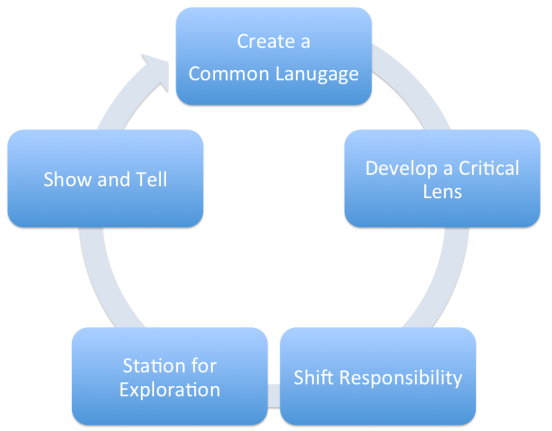Do you want to know the secret to successful multimodal composition instruction? Here are five tips I use when teaching students how words, images, and sounds work together to enhance the author’s message.
 Tip 1: Create a common language about multimodal composition
Tip 1: Create a common language about multimodal composition
Creating a common language, or meta-language, empowers students by giving them the words they need to analyze and discuss their multimodal composition process. Begin by building a class multimodal glossary. First, select one mode to discuss as a whole class: linguistic, visual, audio, gestural, or spatial. Next, write the term on an anchor chart and analyze several examples.
Throughout the day, point out how the mode is used differently in math, science, and social studies. Challenge students to identify ways the mode is used outside of school. When students are ready, work together to create a class definition. By the end of the year, discussions about multimodal composition will be rich with common definitions and concrete examples. Check out MODE’s 2012 multimodal glossary for more terms and definitions.
Tip 2: Develop a critical lens
Research suggests multimodal composition may result in combining modes that distract from the author’s intended meaning. Heighten students’ awareness of effective and ineffective multimodal combinations by analyzing a mode’s affordances and constraints.
Instead of starting with complex media that includes multiple modes, like a commercial, limit the analysis to a single mode. Hassett & Curwood (2009) suggest starting with a picture book to discuss how images and words convey different meanings. For example, an image may support a reader’s ability to make meaning from the words on the page. At the same time, an image may add more information than the words provide. Additionally, an image may contradict or distract from the written message.
Begin by identifying a page for analysis and then lead a discussion by asking:
- How do the images and words work together?
- How do they work against creating meaning?
- Which mode creates the best meaning for this message?
- Are there other modes that might convey a clearer message?
Expand the critical lens by analyzing how images are used in other genres and media such as informational texts, poetry, magazines, blogs, and websites. By talking about how modes can enhance or inhibit meaning, students develop a critical lens. Also, students begin to collect exemplar structures to guide their own composition decisions.
Tip 3: Shift responsibility to students
The gradual release of responsibility model provides an opportunity for honoring a wide-range of semiotic resources. For example, provide direct instruction on how to select and analyze websites, book trailers, or blogs that combine multiple modes. Next, facilitate a discussion while students work in pairs or small groups to select and analyze multimodal resources. Finally, ask students to bring in their favorite multimodal examples to analyze independently. This type of scaffolding strengthens students’ interest in multimodal composition and develops recursive design skills.
Tip 4: Set up a station for exploration
Establishing one computer as a station for exploration allows students to discover their preferred composition pathway. Rish (2013) found his students’ multimodal composition process consisted of three different pathways. Some students utilized modes linearly from linguistic to audio to visual. Other students began browsing digital images and audio files first and then wrote the essay. Still others wrote using a recursive process by moving back and forth between the drafts in digital, audio, and linguistic forms. Providing space for exploration creates ownership and values innovation.
Tip 5: Show and tell
Devote a few minutes each week for students to show the effects of different multimodal combinations or tell about their multimodal composition process. Similar to an author’s chair in writing workshop, students learn how to explain their design decisions and receive constructive feedback from their peers. These student led discussions generate concrete examples of the various processes that can be used for multimodal composition.
Don’t end the school year with the same old writing routine. Use these five tips to remix your instruction and inspire students to be multimodal authors.
 Julie B. Wise is currently a doctoral student at the University of Delaware. She can be reached via email at jbwise@udel.edu.
Julie B. Wise is currently a doctoral student at the University of Delaware. She can be reached via email at jbwise@udel.edu.